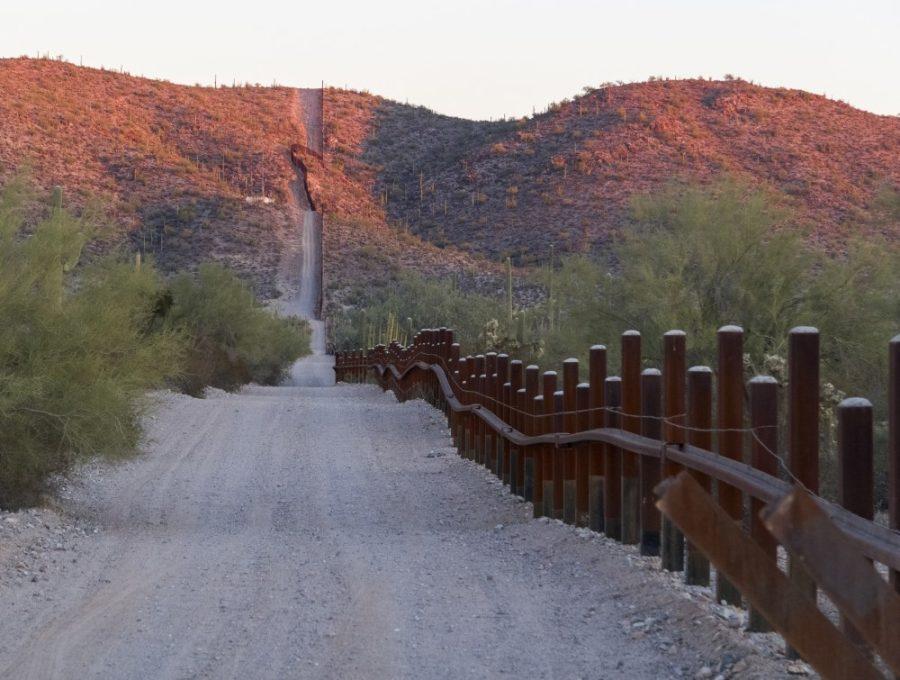The Tucson sector is now the most dangerous sector in the southwest for migrants as well as the busiest with over 64,638 people crossing this past November, according to Border Patrol statistics.
Migrant deaths are not a recent issue. Since the year 2000, the number of migrants who die in the desert north of the border has climbed year after year.
A possible explanation for this trend emerges in the Border Patrol’s militarization of the border with increased presence and barriers to entry gaining traction in the 1990s. This has led those looking to cross to more isolated areas with less Border Patrol presence.
This means the terrain they cross is more rugged and the journey more dangerous. Before the year 2000, the three counties near the border (Pima, Santa Cruz and Cochise) averaged only 20 remains found per year combined, according to Pima County Medical Examiner Dr. Gregory Hess. However, by 2002, this number rose to 151, and in 2020 it reached a high of 223, according to Humane Border’s data.
Last year, Humane Borders reported 173 migrant remains found, and according to Hess, 2023 is on track to surpass last year’s total.
“For us here locally, we won’t consider us being back to baseline unless we are at less than 20, but I don’t see that happening anytime soon,” Hess said.
According to Hess, Pima County has been at the forefront when it comes to tracking migrant deaths along the U.S. border with Mexico. Not only does the county examine bodies found locally, they also examine bodies that come from Cochise and Santa Cruz counties and keep electronic records of those that are determined to be migrants. Due to this, anyone can search those records to find information about these deaths, which are not tracked in the same way in other states like Texas or California.
According to Hess, when remains are found in the desert, whether they are found by Border Patrol, ranchers, hikers or hunters, law enforcement examines the scene initially, and then the remains are brought into the Pima County Medical Center for a post-mortem examination.
“We’ll issue a death certificate, even if we don’t know the cause of death, just to tell the government that someone died, and then we will work through the process of trying to identify them,” Hess said.
This identification can look vastly different on a case-by-case basis, and requires adaptability and attention to detail from those responsible.
“It can be very different depending on the condition of the remains. If someone is in good condition that means that they weren’t in the desert for very long, usually someone that is traveling with them called for help, but help didn’t come in time,” Hess said. “We can do a full examination on someone like that and have a definitive cause of death that is oftentimes related to the environment.”
These examinations often necessitate conversations with those who knew the victim.
“It is not absolute, but we can usually identify someone like that, it just may take a little bit of time because it involves a conversation with family and with the consulate,” Hess said.
There can be other challenges with identifying remains. Many bodies brought in will have documents on them, such as ID cards, but it is not a guarantee that the documents identify who they are.
“It provides a clue to who they could be, but people can use false documents or identification cards, or they may have a reason to not identify themselves. So just because you find an ID in someone’s pockets doesn’t mean it is always them, but it is a place to start,” Hess said. “If you have a name now associated with those remains, based on a card or phone number, you now have a starting point to talk to the consulate or [non-governmental organizations] who collect missing person reports to see if there is any information floating around about that person.”
Remains that are sent to Pima County are not always clear cut. Sometimes there may be nothing but bones to work with, and the only way to identify them is through DNA testing.
A cause of death is also much harder to obtain, due to not knowing how long the bones have been in the desert, which can range from months to years in some cases. DNA testing is also very expensive, and that cost is not something that the medical center can easily cover.
“We do not have any internal county funding for DNA. We can cut samples for DNA, but we need to identify funding to pay to send those samples to the lab to have a DNA profile generated, and that is not even counting getting it from their family, or getting the two samples compared. That is what is so time consuming about it,” Hess said.

Pima County writes grants for funding about every two years, and there are currently 300 samples waiting to be tested, according to Hess. In total, there are 600 skeletal remains stored at the center, along with 800 unidentified remains that were previously cremated in the past when the county had a different policy for unidentified remains.
“That’s good, for a couple of reasons. We don’t have to pay a funeral vendor to cremate or bury them. If we need to examine someone again, we can, and if we figure out who they are, then we can return those remains to the family rather than hand them a bag of ashes. It just has a different feel to it and most people prefer to have the skeletal remains,” Hess said.
The medical center is going to continue this policy for the near future, according to Hess. The center will be moving into a new building sometime next year that will have more space for storage, with a centrally located cooler to store remains that will be more cost-effective than the current set up of differently located coolers.
“I think what we’re doing will get a little bit better with the new facility. We will have a better space to do the work that we do, a better place to store the remains and a better experience for people that are interested in this process than we have right now,” Hess said. “Other than that I think we intend to do things the way we’ve been doing it, and I highly suspect that not much is going to change in the near future.”
Follow the Daily Wildcat on Instagram and Twitter/X














